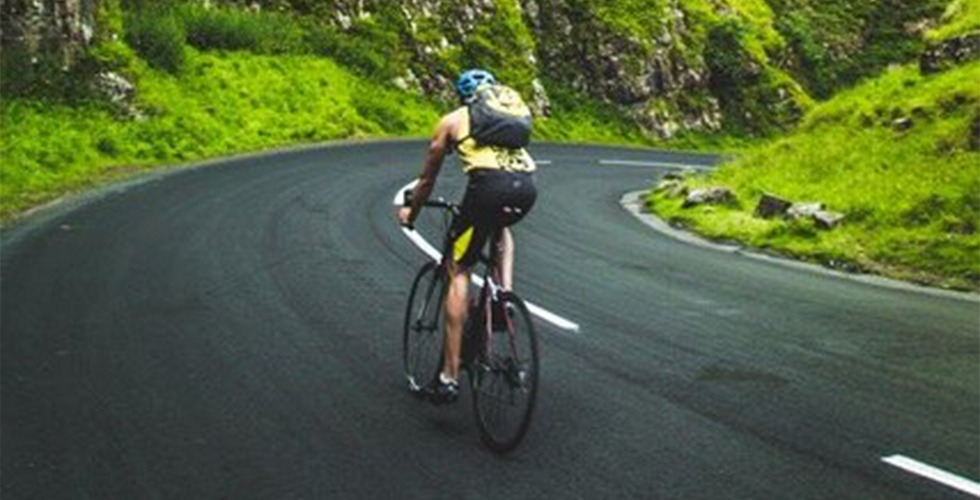I’ve noticed an increase in cycle-related injury enquiries since lockdown and it’s also Bike Week in the UK so I thought I’d share a few hints, tips and exercises to help keep you injury-free and pedalling without pain!
Cycling is a high-load, repetitive activity which can lead to muscle overload, fatigue and pain. I commonly see cycle-related neck, lower back, knee, hand and ankle problems in clinic, many of which, if they’re non-traumatic, could be prevented or reduced by following these 5 tips:
1. Get a Bike Fitting!
Arranging a bike-setup check with a professional bike-fitter is a must, even if you’re a ‘weekend warrior’ cyclist, as incorrect setup can lead to unnecessary stress on muscles and abnormal forces through the joints. An alteration to saddle-height, handlebar position or cleat fit, even by as little as a couple of millimetres could make a huge difference to your comfort and performance on the bike. For any cyclist suffering from back or any joint pain, or any cyclist wanting to prevent pain and improve performance a bike fit should be an integral part of the plan!
2. Practice High Cadence
Getting into the habit of using a higher cadence (90rpm or above) will be less stressful through hips, knees, lower back and ankles than grinding through the big gears. Spinning more will challenge your cardiovascular system to begin with, but with some practice it will become easier and your joints will thank you. Remember to use the gears when there is any increase in gradient too. Vary the muscles which are in use, particularly on longer rides, by altering position: Stand up from sitting to increase some lumbar spine extension, taking the load off the lower back muscles and discs; and push through the mid-part of the foot to avoid too much load on calf muscles or being pushed too far forwards onto handlebars.
3. Build a Strong Core
The ‘core’ muscles are not simply the ‘abs’ as many people think. Its actually a complex group of muscles located in the trunk, between the hips, up through the abdominals, the spine and into back of shoulders and neck. They are key muscles for cyclists as a strong, functional core provides a platform for the legs to push against, enabling more power whilst using less energy, helping to reduce muscle fatigue and pain. Core awareness also improves balance- vital on the bike generally- and for taking corners safely and efficiently.
4. Improve Flexibility
Tightness of hamstrings, glutes, hip flexors and lower back muscles are commonly seen in cyclists and can be a contributing factor in cases of lower back, knee and hip pain. The hamstring group of muscles originate from the seat bone region of the pelvis , so when they are tight they can pull down on the pelvis, leading to an overly flexed position in the lumbar spine which can cause compression of the intervertebral discs and abnormal tensile load on the lower back muscles. Improving mobility through other forms of exercise such as stretching, walking, yoga and pilates can be massively helpful for cyclists hoping to reduce pain and up performance.
5. Vary the Intensity of Training Sessions
This applies to amateurs and experienced cyclists alike. Increasing mileage too rapidly could lead to overload on joints and soft tissues which will inevitably result in injury and/or pain. If muscles aren’t conditioned to endure the stress of the workout, there will be a compensatory effort made elsewhere in the body, or the stressed area will become painful. Vary cycle training with strength and flexibility training, other cardio workouts, rest days and increase cycle mileage gradually (20% per week max).
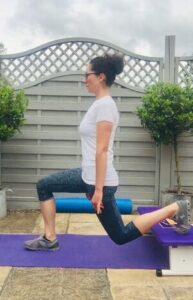

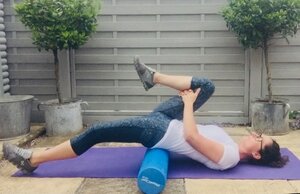
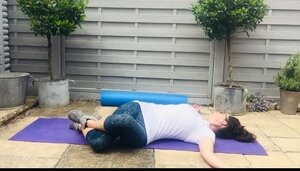

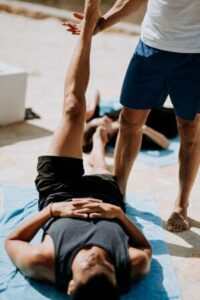
Here is a range of relevant exercises which will benefit cyclists…a mix of strength and flexibility to help prevent pain and improve your performance on the bike! Have fun!
The Bulgarian Split Squat: Tough but worth the effort for cyclists as this exercise targets legs, glutes, core and lower back muscles.
- Bend front knee towards 90 degrees, don’t allow knee to travel forwards of toes.
- Keep weight in front heel, keep body upright, head facing forwards.
- Lower rear knee almost to the floor and keep breathing!
- Maintain neutral spine throughout.
- Push with front heel and straighten front leg to raise back up to start position.
- Aim for 5 reps per side, but practice quality rather than quantity!
Bridge: For spinal articulation which can be missing in cyclists!
Lie on back with feel and knees hip width apart and allow the pelvis to tilt back towards belly button, then gently begin to peel the spine up and away from floor vertebra by vertebra until a straight line is achieved from knees, hips and shoulders. Keep the sternum soft and don’t flare ribs up. Replace spine onto floor vertebra by vertebra and repeat X 5.
Hip Flexor Stretch: Hard working muscles in cyclists responsible for the upstroke of the pedal revolution.
Lie on back with a foam roller under sacrum (back of pelvis, not lower back). Pull one knee up towards chest and allow other leg to extend along floor. The stretch will be achieved on the extended leg. Hold 20-40 seconds and repeat on the opposite leg.
Glute Stretch: Lie on back, knees bent, arms out either side at shoulder height. Cross one leg over the other and then use top leg to encourage lower half of body to roll gently to one side. Allow head and neck to softly roll to opposite side, away form direction legs have rolled to. This is a good stretch for the hip rotator muscles and glutes which are heavily utilised muscles for the cyclist and often get very tight. Tightness in these muscles can contribute to back and knee pain.
Superman: A great strength challenge exercise targeting glutes, multifidus (deep spinal muscles), core and hamstrings! A nice little balance challenge too!
Begin on hands and knees, hands under shoulders, knees under hips. Find neutral spine and push little fingers into mat. Keep length in spine and begin to slide opposite arm and leg away from the body, foot reaching backwards and hand reaching forwards. Try to keep the pelvis steady, as if there was a glass of water balancing there. Slowly return arm and hand to start position and repeat the opposite side.
Hamstring Stretch: The big muscles at the rear of the thigh are often tight in cyclists so stretching regularly alongside the other strength exercises shown here can really help to minimise injury and lessen the chance of suffering from hamstring-related lower back pain.
Lie on back and pop a scarf or exercise band over the ball of the foot. Use the scarf to gently guide the leg up in the direction of the ceiling until a gentle stretch is felt at the back of the thigh. You can also ask somebody to help support the leg for you rather than use the scarf or band… as shown in the picture here. Hold 20-40 seconds.
Hope you’ve enjoyed reading this Blog post! If you’d like to know more about how chiropractic may benefit you alongside exercises such as these please just ask! Email alex@thecotswoldchiropractor.co.uk or call 07980662229.

